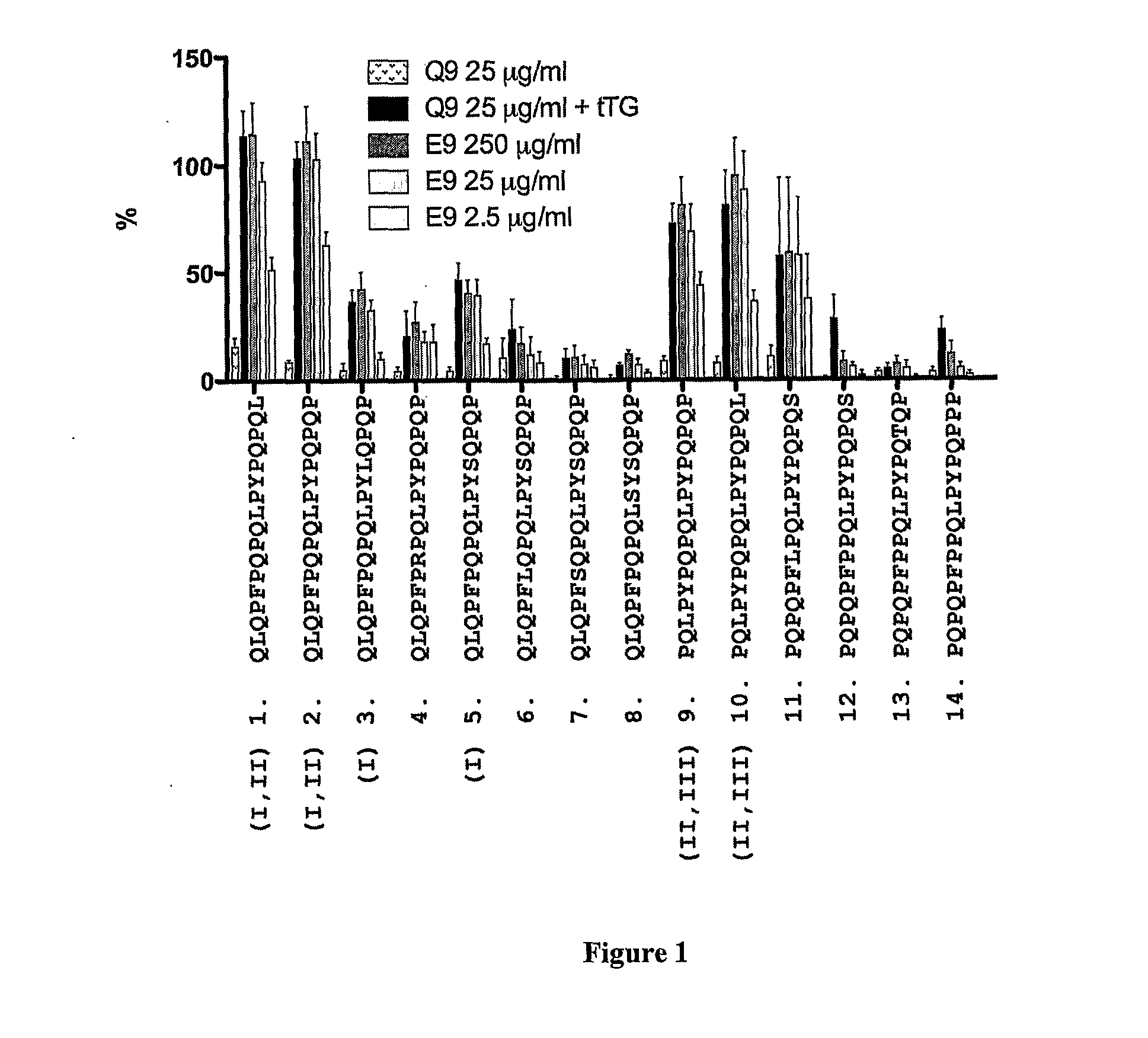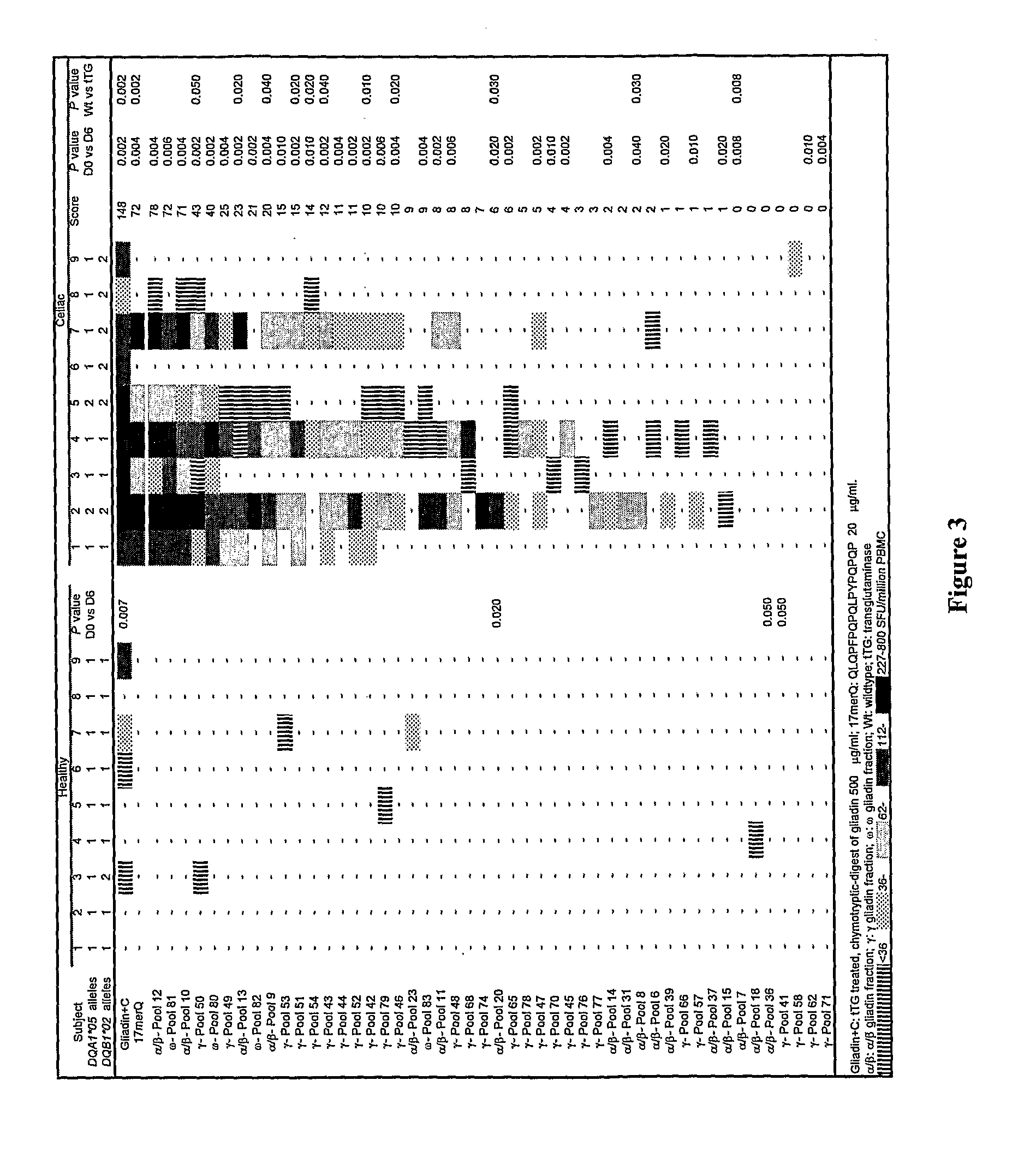Compositions and methods for treatment of celiac disease
a technology for celiac disease and compositions, applied in the field of compositions and methods for treating celiac disease, can solve the problems of increasing cancer risk, osteoporosis and death, difficult to maintain a gluten-free diet, etc., and achieve the effect of improving the half life and/or bioavailability of peptides
- Summary
- Abstract
- Description
- Claims
- Application Information
AI Technical Summary
Benefits of technology
Problems solved by technology
Method used
Image
Examples
example 1
Determination of Immunodominant Peptides
Subjects
[0286]Volunteers were adults aged 18-70 years and following strict gluten free diet. All volunteers possessed genes encoding both HLA DQAB1*05 and HLA DQB1*02 as determined by PCR with sequence-specific primer mixes of peripheral blood DNA (Bunce et al., 1995; Olerup et al., 1993; Mullighan et al., 1997). Volunteers with celiac disease were diagnosed on the basis of ESPGAN criteria (Report of Working Group of European Society of Paediatric Gastroenterology and Nutrition, 1990). Subjects with celiac disease undergoing gluten challenge were on gluten free diet for at least 1 month and claimed to be compliant (positive tTG-IgA or EMA was an exclusion). Healthy HLA DQ2 subjects (endosmysial IgA negative) had followed a strict gluten free diet for 4 weeks before commencing gluten challenge.
Three-Day Gluten Challenge
[0287]Wheat challenge: Two 50 g slices for breakfast and for lunch of either Sainsbury's “standard white sandwich bread” (UK—to...
example 2
Determination of the Primary Dominant Peptides Using Fresh Polyclonal T Cells Induced by In Vivo Gluten Challenge
[0298]In previous studies, it has been found that gluten-specific T cells are at their peak in blood 6 days after HLA DQ2+ celiac disease donors commence oral gluten challenge. On day-6, IFNγ ELISpot responses of PBMC from celiac disease donors to optimal concentrations of tTG-treated gliadin (500 μg / ml) and α-gliadin p57-73 QE65 (SEQ ID NO:8) encompassing DQ2-α-I (SEQ ID NO:3) and DQ2-α-II (SEQ ID NO:4) epitopes were significantly correlated (r=0.80, p<0.0001). Median IFNγ ELISpot responses to 17mer were 51% (n=17, range: 0-155%) of those to tTG-treated gliadin (500 μg / ml). However, the α-gliadin p57-73 QE65 (SEQ ID NO:8) was not always immuno-dominant. IFNγ ELISpot responses were equivalent to less than 5% of those to tTG-treated gliadin in 3 / 17 donors (Anderson et al., 2005).
[0299]Based upon these observations, it is clear that gluten peptides additional to the α-gliad...
example 3
NexVax2 in Mouse Model
[0337]The optimal administration and dose regimen of a peptide-based therapeutic vaccine to induce clinical tolerance to gluten and remission of celiac disease while consuming gluten is not known. However, an essential property of any peptide-based therapeutic would be its ability to activate cognate T cells in the target organ in vivo.
[0338]The interaction between NPL001 (SEQ ID NO:228) and cognate T cells in vivo has been modelled by developing transgenic Black-6 mice expressing functional HLA-DR3 and -DQ2 (but not murine MHC Class II molecules) on antigen presenting cells (APC) who are transferred 3×106 CFSE labelled CD4 T cells specific for NPL001 (Chen Z., et al., 2006). The donor mouse (HH8-1) is transgenic for the NPL001-specific T cell receptor and human CD4 expressed on T cells, and also expresses HLA-DR3 DQ2 on APC. Overall 96% of the CD4+ T cells in the HH8-1 mouse are clonal and specific for NPL001 (results not shown).
[0339]Four days after subcutane...
PUM
| Property | Measurement | Unit |
|---|---|---|
| temperatures | aaaaa | aaaaa |
| Tm | aaaaa | aaaaa |
| time | aaaaa | aaaaa |
Abstract
Description
Claims
Application Information
 Login to View More
Login to View More - R&D
- Intellectual Property
- Life Sciences
- Materials
- Tech Scout
- Unparalleled Data Quality
- Higher Quality Content
- 60% Fewer Hallucinations
Browse by: Latest US Patents, China's latest patents, Technical Efficacy Thesaurus, Application Domain, Technology Topic, Popular Technical Reports.
© 2025 PatSnap. All rights reserved.Legal|Privacy policy|Modern Slavery Act Transparency Statement|Sitemap|About US| Contact US: help@patsnap.com



